These tiny loaves that look like nests or flowers are some of the most beautiful bread that I have ever made. This is Pane Di Pasqua, a traditional Italian Easter Bread. These are soft, lightly sweet, pretty, and of course delicious.
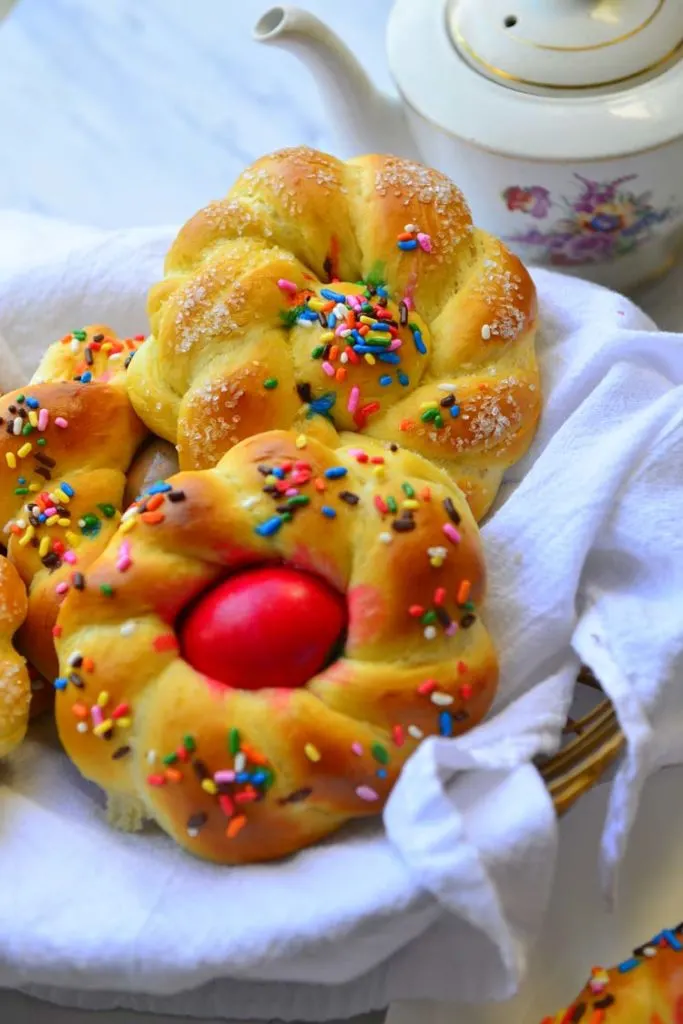
These pretty loaves of bread are Pane Di Pasqua -the Italian Easter Bread. The ones with colored eggs in the middle look like one fancy bird nest. I have made a few without the egg – and they ended up looking like pretty flowers. See that got me in trouble – now I can’t decide which is prettier! Guess I just have to make a few more 😂
The Tradition of Easter Breads
Traditionally Easter bread is rich, as it is a celebratory bread marking the end of lent. There are traditional Easter bakes in many parts of the world each rife with symbolism. The circular braids are meant to signify the crown of thorns that Jesus wore and the eggs signify rebirth. Whether you believe in the symbolism or not it is a beautiful bread.
Eggs as a Symbol of Life
Easter celebrations around the world feature eggs and color. Eggs, though dormant it still contains life, and cracking it open is symbolic of resurrection. Many places, especially in Greece, dye the eggs red – representing the blood of Jesus. The eggs in Pane Di Pasqua are dyed in all colors.
Spring Baking
To me, this version resembles spring flowers and all the brightness to look forward to after the winter – which incidentally is non-existent this year. So I guess I was making up for the spring flowers with the sprinkles! But I must confess that even though I like the colorful sprinkles I am partial to sparkling sugar.

Ingredients for Pane Di Pasqua
This Easter bread is made with enriched dough. In addition to the standard breadmaking ingredients here are eggs, sugar, butter, spices, extracts, and fruit are added to the dough. All these additions mean that the dough rises slowly, taking 2 to 3 times as much time compared to the standard white bread dough. So plan ahead, and check out the sample schedules given below the recipe.
- Flour: It is best to use bread flour for this bread. All-purpose flour with high protein content (11% or more) will work well too.
- Sugar, butter, eggs: I have cut back a little on the sugar but you can double the amount of sugar used in my recipe. Do not reduce the butter or sugar though, these are necessary for the tender soft crumb.
- Spices and flavorings: In addition to orange zest, anise, spice extracts, and dried fruits can also be added.
Making the Bread Dough
The dough for this bread is a little wet. This ensures that the braids do not come apart while baking. Wet doughs, by their very nature, stick to surfaces and are more difficult to handle. So I prefer to use the machine for most of the kneading. It can be done by hand, just be ready for sticky fingers, and have extra bench flour ready to use. Even though the machine does most of the heavy lifting, one still has to finish the kneading by hand.
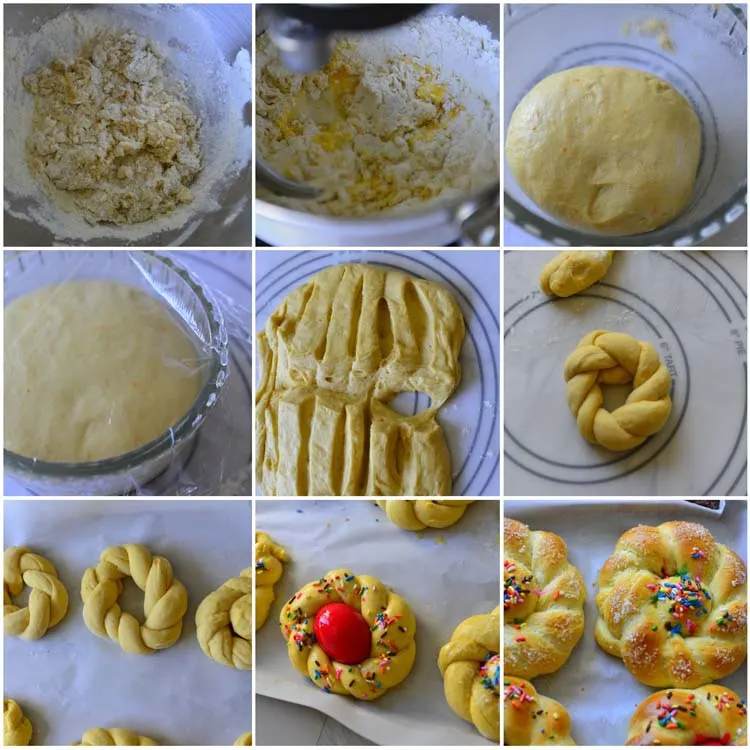
Make the sponge
We start by making a sponge. For this take 1 C flour (for 1 quantity of the recipe mentioned below) and ¼ C sugar in the mixing bowl. Mix well and add the yeast. Pour ½ C milk over it, stir well, and set aside for 10 minutes. There may be bits o dry flour, but don’t worry about it. At the end of 10 minutes, the mix would have visibly puffed up (pic 1 in the collage above).
Make the dough
Make the dough by hand or by using a mixer. Knead the flour, salt, eggs, and the sponge together adding milk as necessary. Once the dough comes together knead in the softened butter, the flavorings, and zest. This takes about 3 minutes in the machine and about 10 minutes by hand. The dough should be a little loose, but no floppy. If you shape it into a ball and place it on a flat surface it will flatten a little, but won’t lose its shape completely.
Whether kneading by hand or machine, use hands to knead in any fruit.
Bulk Proof / First Rise
Place the dough in a greased bowl and turn it over once to coat all sides with oil. Cover with plastic wrap (damp towel or a fairly tight lid). Place the bowl in a warm place and allow the dough to rise until doubled, about 1and 1/2 to 2 hours.
Shaping the Italian Easter Bread
I have made a basket of mini wreaths here, but you can make a large wreath as well. It will be a pretty impressive centerpiece on the Easter table! Another option is to create a large bird’s nest. Set aside a portion of the dough to make one or 2 long thin ropes and use the remaining dough to create a large braid. Join the braid in a circle to form a wreath. Use the long rope/s to fill the center in any woven pattern. Place the eggs in the center for the final touch.
To shape, start by punching down the risen dough. Generously flour a work surface and place the dough on it. Pat down to a thick rectangle. Divide into 12 even pieces for the small wreathes. Or 3 large equal pieces and a small piece for a larger wreath as described in the paragraph above.
Making the Small Nests or Wreaths
Roll each piece to form a rope of about 14 to 16 inches in length. Take two ropes and twist them together. Loop the twist into a circle and interlace the ends and tuck them under. Transfer the circles onto a baking sheet lined with parchment paper. If making the filled circles, pinch off a piece from the rope before connecting the ends. Roll the pinched piece into a ball and place it in the center.
The braids do not have to be perfect. Twist two ropes together and tuck the ends into each other to form a circle. Watch the video for more details
Bake
Wait for the shaped loaves to double in size, about 30 minutes. Brush with egg wash and add the sprinkles on top. Place the dyed egg at the center of the circles and bake.
Glaze
This bread is lightly sweet. If you prefer a sweeter loaf, double the sugar given in the recipe, and once the bread is out of the oven give it a sugar glaze. If glazing after baking, add the sprinkles only after glazing.
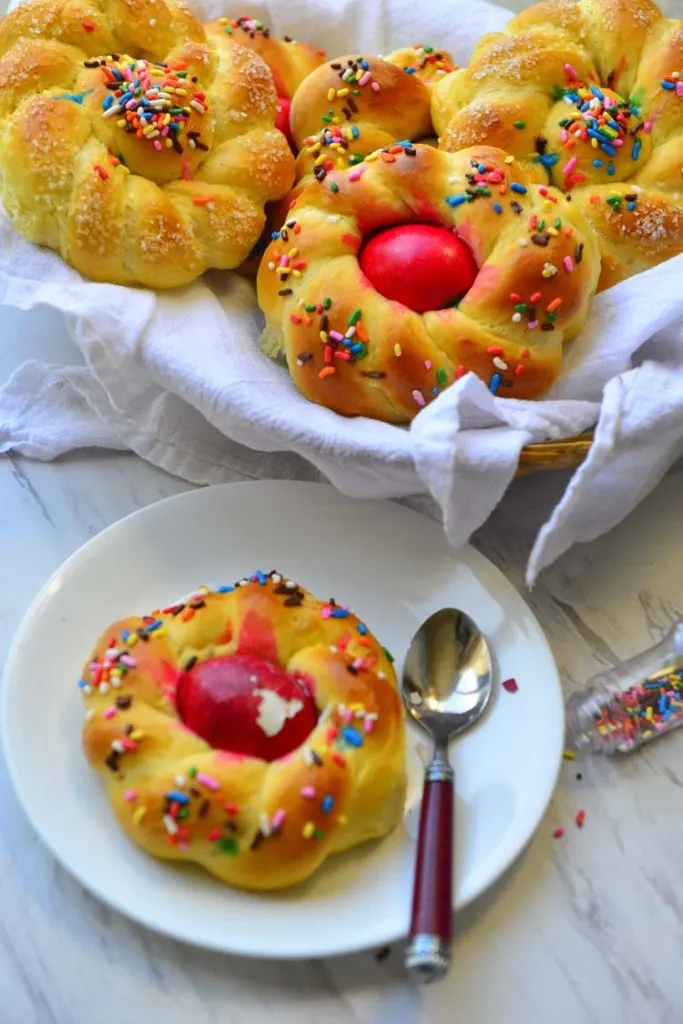
The egg is dyed raw and goes into the oven raw. It gets cooked while the bread is baking. Use the spoon to crack open the shells :-). Yes, that is why there is a spoon with the bread. I think these rolls spent close to 25 minutes in 350°F (170-175C – See the conversion chart) oven and the eggs were cooked perfectly – just set and no black ring around the yolks.
The dye from the egg spreads a little to the bread. If you prefer to avoid this use undyed eggs or place cooked dyed eggs in the center after the bread is baked.
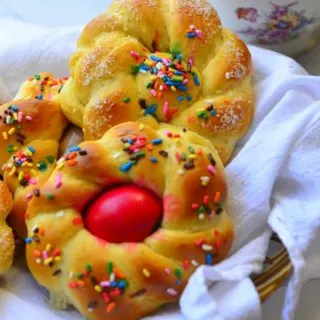
Pane Di Pasqua
Ingredients
- 3 1/2 – 4 C AP Flour / Bread Flour 400 g
- 2/3 C Milk Full fat or Skim
- 1/4 C Sugar
- 1/4 C Butter Unsalted
- 2 Eggs Large
- 2 1/4 Tsp Active Dry yeast 1 pkt
- 1/2 Tsp Fine Sea Salt
- 1 Tbsp Orange/Lemon Zest Optional
- 1 Tsp Anise/Almond Extract Optional
- 1/4 C Golden Raisins or any dried fruit Optional
Egg Wash
- 1 Egg
- 1 Tsp Water
To decrate
- Sprinkles / Sparkling Sugar / Pearl Sugar As Needed
- Raw Dyed Eggs As Needed (4- 6)
Glaze
- 1 C Icing Sugar
- 1 – 2 Tbsp Water/Milk
- 1/2 Tsp Vanilla Extract
Instructions
Bloom Yeast/ Make Quick Sponge
- Warm the milk to 110°F or just warm to touch. Make sure that the eggs and butter are at room temperature.
- Take 1 C flour and 1/4 C sugar in the mixing bowl. Stir to combine. Sprinkle the yeast on top and pour about 1/2 of the milk. Mix and set aside for 10 minutes. The mix would have visibly puffed up by then.
Knead With Stand Mixer
- Add the remaining milk, eggs, butter, salt, and 2 1/2 C flour to the bowl. Attach the dough hook and stir to combine for 30 seconds. Increase speed to low and knead for 2 minutes scraping down the sides in between. The dough will be very sticky. After 2 minutes of kneading if the dough is still sticking to the bowl, turn off the machine and add the remaining flour. Turn the machine back on and add the essence and zest. Knead for 2 to 3 minutes.
- Turn the dough out to a floured work surface and knead by hand for about 1 minute. If adding dry fruit do it at this time. Form into a smooth ball.
Knead By Hand
- Mix flour, salt, and butter into a pile on a well-floured kneading surface. Make a well in the middle and add the yeast mix. Beat the egg a little and add to the mix. Slowly incorporate the flour into the wet mix in the middle adding as much of the milk as necessary. Once the dough has comes together add the softened butter, essence, and zest. Knead for about 10 minutes until the dough feels soft and elastic and visibly shiny. It should no longer stick to the surfaces. If needed add a few more tablespoons of flour. Finally, add the dry fruit and knead for about a minute until the fruit is distributed evenly.
Bulk Proof / First Rise
- Place the dough in a greased bowl and turn it over once to coat all sides with oil. Cover with plastic wrap (or a wet towel or a fairly tight lid) and allow the dough to rise in a warm place, about 1 hour and 30 minutes.
Shape and Rise
- Gently punch down the risen dough to deflate. Transfer to a floured work surface and pat down to a thick rectangle. Divide into 12 even pieces.
- Roll each piece to form a rope of about 14 to 16 inches in length. Take two ropes and twist them together. Loop the twist into a circle and interlace the ends and tuck them under. Transfer the circle onto a baking sheet lined with parchment paper.
- If making the filled circles, pinch off a piece from the rope before connecting the ends. Roll the pinched piece into a ball and place in the center.
- Cover with plastic wrap and set aside to double in size, about 30 minutes.
Bake
- Place the oven rack in the center. Preheat the oven to 350°F (170°C).
- Beat 1 egg with 1 tsp of water to make the egg wash. Use a pastry brush to coat the tops of the loaves with egg wash. If not glazing later, sprinkle sugar or decorative sprinkles on top. Place the colored raw eggs in the middle of the shaped circles.
- Transfer to the oven and bake for 20 to 25 minutes until the tops of the bread begin to brown a little.
- Transfer to a cooling rack.
Glaze (Optional)
- Mix the confectioner’s sugar, vanilla extract, and milk/water to form a thick paste. Drizzle over the warm loaves. Decorate with sprinkles
Video
Notes
- Use flour with good protein content.
- You could let the dough rise slowly in the fridge (first rise/bulk proof) overnight.
- Double the sugar for a sweeter version. In this case, the dough will need longer than 90 minutes to double in size.
- You can easily double or triple the recipe.
- When making the quick sponge make sure that you mix the flour and sugar before adding yeast.
- If doubling sugar, add the extra sugar along with the extracts.
Important: Nutrition Values are estimates. Actuals vary based on ingredients and serving size.
Sample Baking Schedules
Schedule 1
This is the standard schedule when you have a 4 hour block
- Hour 0: Start making the dough
- 0:30 Hours: Start first rise
- 2 – 2:30 hours : Punch down and shape
- 2:30 – 3:00 : Start second rise
- 3:00 – 3:30 Bake
Schedule 2
Use this schedule when you don’t have long window of time to devote to baking. Here we slow down the yeast activity by chilling the dough, so it takes longer to rise.
- Day 1 Morning/ Evening : Make the dough. Make sure that the dough is liberally coated with oil and place in a large bowl. Cover the bowl with plastic wrap or a lid and moist towel and refrigerate for 12 to 18 hours
- Day 1 evening / Day 2 Morning: Remove the dough from fridge and let it come to room temperature (about 30 minutes). Shape and bake
How to dye the raw eggs
I am at a disadvantage here. This is not my area of expertise and to be honest, I end up making a mess every time. I am surprised that the colors on my fingers did not show up in the video.
This is how Id do it – if anyone has a better way I would love to hear about it!
In a small mug or cup large enough to hold the egg, place 1 tsp white vinegar and about 10 drops of food coloring. Pour a little hot water, a few tablespoons, and mix. Now add the egg, if the water does not cover the egg add more hot water and stir with a toothpick to ensure that the color is uniform. Let it sit for 5 minutes. Remove from the bowl, wipe dry with paper towels. Spray oil on top and store till needed.

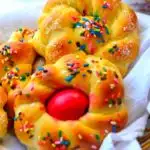
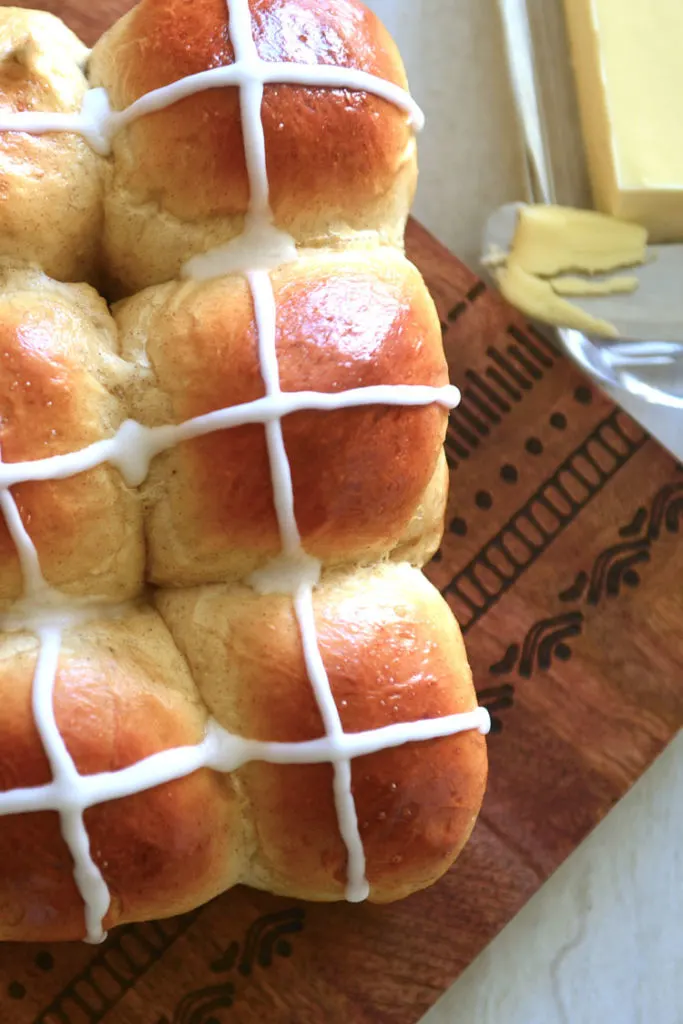
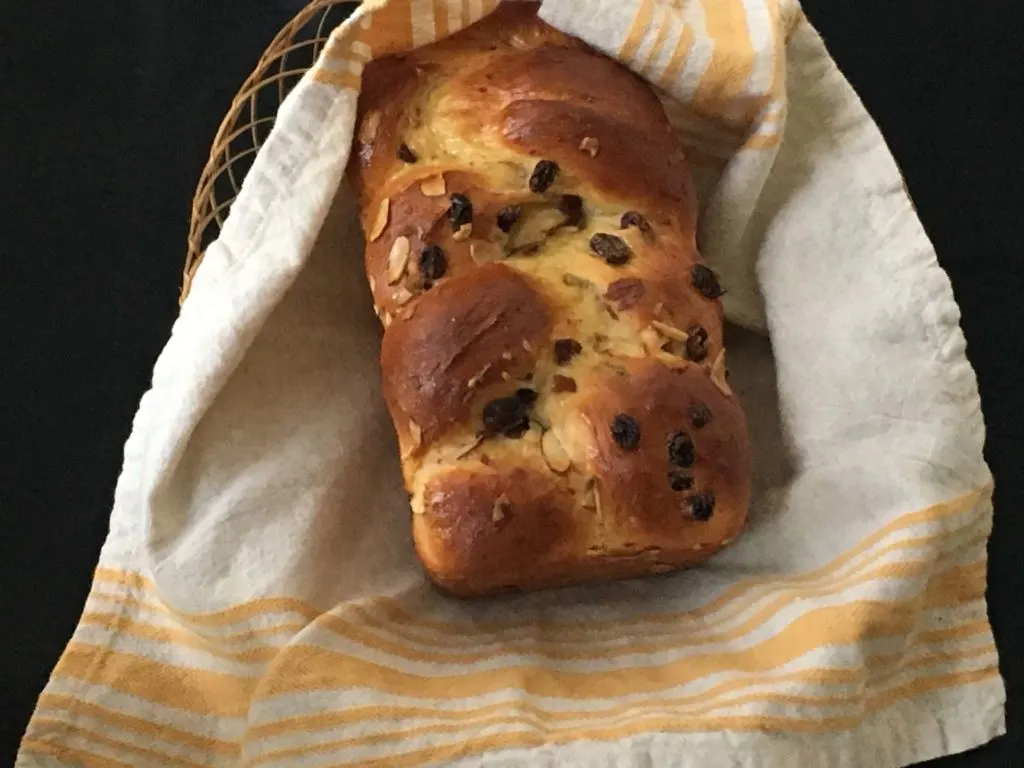
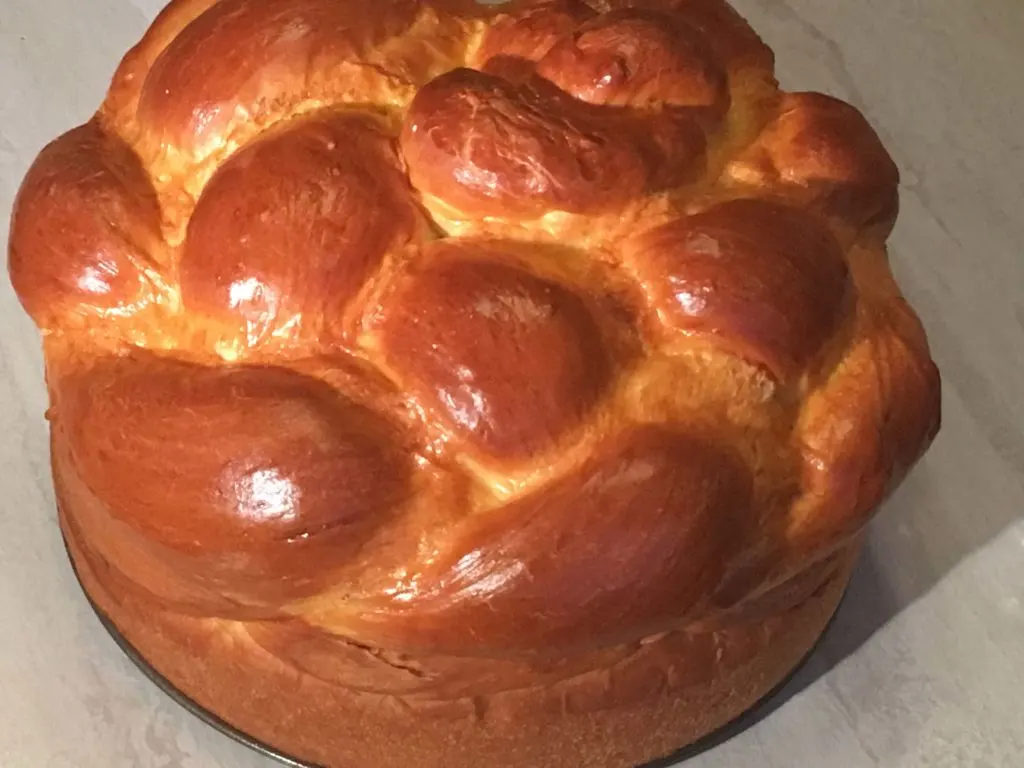
Pane Di Pasqua - Italian Easter Bread | Delight Baking
Thursday 29th of October 2020
[…] This recipe was inspired by Pane Di Pasqua. […]
Aleka
Sunday 1st of April 2018
I love a good sweet bread!! My family always dies them red (we’re Greek) so this would be perfect to make for next weekend! We then play a game by cracking the eggs to see who has the strongest egg! :)
Syama
Monday 2nd of April 2018
Wow , that is so neat ! I see the significance of red. This is such a fun bake , for us and the kids!
Brian Jones
Sunday 1st of April 2018
Oh my they sound really superb, I reckon no egg for me, but hey both look stunning!
Syama
Sunday 1st of April 2018
Thank you ! I would go with the no egg one too , if it weren't for Easter :-)
Ramona
Saturday 31st of March 2018
These Easter breads look amazing - so colourful and cheerful - my kids would adore these - might get some time to do it over this Easter period ;-) a definite must make - thank you so much for sharing this yummy and such good looking recipe. ;-)
Syama
Sunday 1st of April 2018
Thank you ! I hope you get time to make it :-)